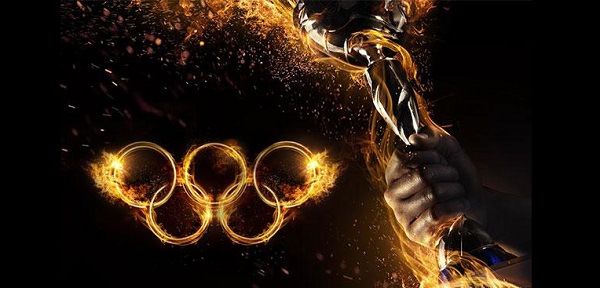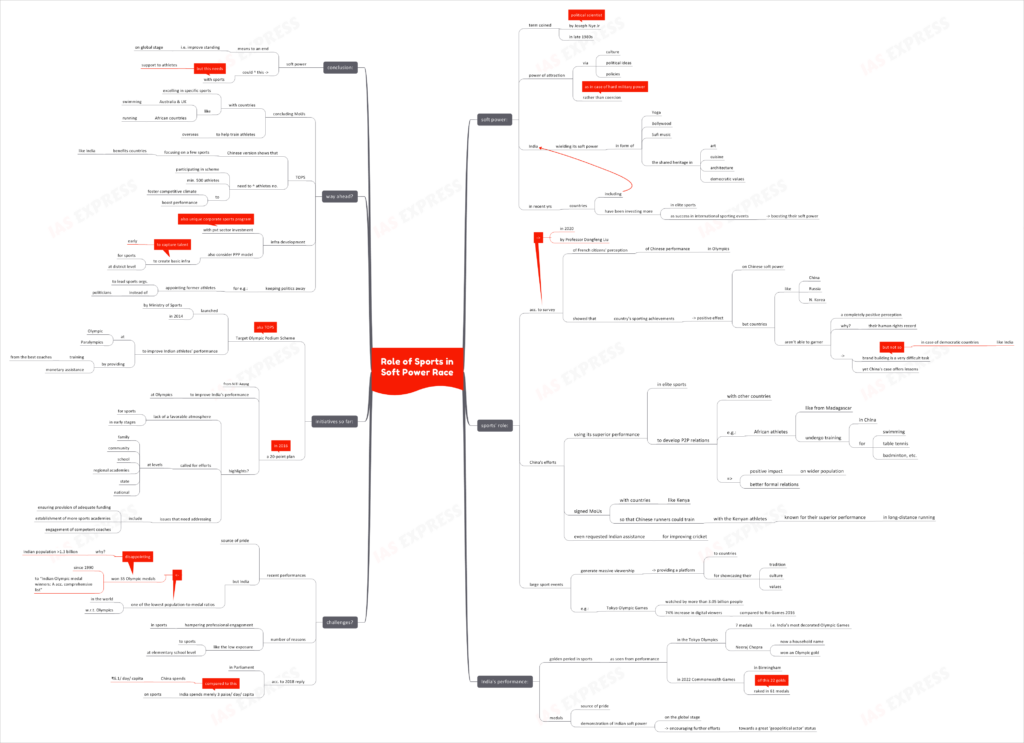Role of Sports in the Soft Power Race

This topic of “Role of Sports in the Soft Power Race” is important from the perspective of the UPSC IAS Examination, which falls under General Studies Portion.
What is soft power?
- The term ‘soft power’ was coined by Joseph Nye Jr., a political scientist, in late 1980s.
- Unlike in case of military hard power, it is the “power of attraction through culture, political ideas, and policies rather than coercion”.
- Over the years, India has been wielding its soft power in the form of Yoga, Bollywood, Sufi music and the shared heritage in art, cuisine, architecture and even democratic values.
- In the recent years, countries, including India, have been investing more in elite sports as success in international sporting events is boosting their soft power.

What is the role of sports in the soft power race?
- In 2020, a survey of French citizens’ perception of Chinese performance in the Olympics, by Professor Dongfeng Liu, showed that the country’s sporting achievements had a positive effect on Chinese soft power.
- Despite this, countries like China, Russia and North Korea aren’t able to garner a completely positive perception as a consequence of their human rights record. Hence, brand building is a very difficult task for such countries.
- However, in case of democratic countries, like India, such factors don’t hamper their soft power growth. Even so, China’s case can be used to understand the role of sports in soft power.
- China has been using its superior performance in elite sports to develop P2P relations with other countries. Eg: African athletes (from countries like Madagascar) undergo training in China- for swimming, table tennis, badminton, etc.
- This translates to a positive impact on the wider population and better formal relations.
- China has also signed MoUs with countries like Kenya so that the Chinese runners could train with the Kenyan athletes, known for their superior performance in long-distance running.
- It has even requested Indian assistance for improving cricket.
- Large sports events generate massive viewership, providing a platform for the countries to showcase their tradition, culture and values.
- For instance, the Tokyo Olympic Games was watched by more than 3.05 billion people– a 74% increase in digital viewers compared to Rio Games 2016. This shows that there is a great opportunity in using such events as a platform to boost soft power.
How has India been performing?
- Recently, India has been witnessing a golden period in sports, as seen from the performance in the Tokyo Olympics and the 2022 Commonwealth Games in Birmingham.
- The recent performance- 7 medals- was India’s most decorated Olympic Games in the country’s history.
- Javelin thrower Neeraj Chopra, who won an Olympic gold, is now a household name.
- At the CWG, India raked in 61 medals of which 22 were golds.
- These medals are not only a source of pride to the citizenry, but are also a demonstration of Indian soft power on the global stage, encouraging further efforts towards a great ‘geopolitical actor’ status.
What are the challenges?
- While the recent performances have been a source of pride, India still has one of the lowest population-to-medal ratios in the world, when it comes to the Olympics.
- India has won 35 Olympic medals since 1990, according to “Indian Olympic medal winners: A comprehensive list”. This is disappointing given the country is home to over 1.3 billion people.
- There are a number of reasons hampering professional engagement in sports like the low exposure to sports at elementary school level.
- According to a 2018 reply in the Parliament, India spends merely 3 paise/ day/ capita on sports. In comparison, China spends ₹6.1/ day/ capita.
What efforts have been taken?
- The TOPS or Target Olympic Podium Scheme was launched by the Ministry of Sports in 2014.
- It seeks to improve Indian athletes’ performance at the Olympic and Paralympics Games.
- It provides training from the best coaches– both national and international- to the participants.
- In addition to this, the scheme also provides for monetary assistance.
- The NITI Aayog gave a 20-point plan, in 2016, to improve India’s performance at the Olympics.
- The plan highlighted the lack of a favourable atmosphere for sports in the early stages of the athletes’ journey.
- It called for efforts at family-, community-, school-, regional academies-, state- and national-levels.
- Some of the issues that require addressing include ensuring provision of adequate funding, establishment of more sports academies and engagement of competent coaches.
What is the way ahead?
- Concluding MoUs with countries excelling in specific sports could help India improve its performance. For instance, Australia and UK could help train Indian athletes in swimming. African countries could help athletes in running events via collaborating training programs.
- Chinese version of the TOPS has demonstrated that focusing on a few sports benefits countries like India. However, there is a need to increase the number of athletes participating in the scheme. At least 500 athletes need to be covered under TOPS to foster a competitive climate and boost performance.
- Infrastructure development could do with private investments. Leading corporates have already shown how their participation and investment helps improve spots performance through their unique corporate sports programs. The government could consider PPP model to create basic sports infrastructure at district level, as recommended by the NITI Aayog. This will help capture athletic talent at an early age.
- The government must make sure to keep politics away from sports. Sports organizations must be led by former athletes, rather than politicians.
Conclusion:
Soft power is a means to an end, not the end itself. It would help cement India’s standing in the global arena. Sports could very well help India boost it soft power. However, efforts are needed to support the athletes who could make this happen.
Practice Question for Mains:
Examine the significance of sports as a soft power tool for a country like India. (250 words)

